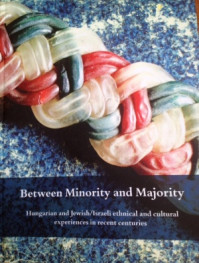
"On May 4-6, 2011 in cooperation with historians from Hungary and Israel, the Balassi Institute organized a conference entitled “Between Minority and  Majority” on the history of the Hungarian and Jewish diaspora and the shifting meanings of notions of Hungarian and Jewish identity.
Majority” on the history of the Hungarian and Jewish diaspora and the shifting meanings of notions of Hungarian and Jewish identity.
This book contains essays based on the presentations given at the conference. From the perspective of its subject, the conference broke with an approach that in general tends to prevail in conferences held for a Hungarian speaking audience on topics related to Jewish history and culture. The presentations that were held treated Hungarian history and Jewish history (and naturally also the history of Hungarian Jewry) not simply as a kind of “Passion,” i.e. a narrative of sufferings, but considered instead the question of the essence and substance of these groups themselves, their points of cross-cultural intersection, and their similarities and differences from the perspectives of sociology and historiography. The histories acquired meaning both through their historical continuity and through comparison, thereby also creating a possibility for dialogue. The examination of Hungarian and Jewish identity was extricated from the framework of the narrative of sufferings that came into being as a consequence of Trianon and the Holocaust, a narrative framework that bears unquestionable legitimacy, but which the authors nonetheless sought on this occasion to transcend. Instead, the conference presented, from the perspectives of general and individual history, the inextricably and sometimes almost imperceptibly intertwined realities of these communities.
Various questions arose in connection with this. When and how did the Hungarian diasporas come into being, and what teleological or pseudo-teleological meanings have been attributed to their origins (Tamás Turán)? How did the diaspora communities evolve in various countries, such as Hungary, Israel (Rafael Vago), the United States (Attila Z. Papp), and Argentina (Nóra Kovács). The presentations provided a new perspective on a common historical space in which new insights were shed on the American-Hungarian diaspora community, the Hungarian Jewish diaspora in Buenos Aires, the old Jewish communities of Transylvania and present-day Slovakia (Attila Gidó, Gusztáv Filep Tamás).
There was also a presentation on the influences of the Hungarian and Jewish musical traditions on each other and the music of Central Europe (Judit Frigyesi). The question of diaspora and national identity also arose (Yuli Tamir) as did the issue of the role of diaspora in politics (Levente Salat). Presentations addressed old educational customs among the Hungarian Jewry (Viktor Karády), identity strategies that were adopted after 1945 (András Kovacs), the future prospects for the German and Hungarian Jewry in Europe under Nazi rule (Guy Miron), the Hebrew language as a nation building tool (Viktória Bányai), and the changes that took place in Hungarian Jewish identity as a consequence of experiences in the concentration camps (Szabolcs Szita). The presentations also included a discussion of the letters that were written by Hungarian Jews to Pál Teleki during his time as Prime Minister in the hopes of soliciting his aid (Balázs Ablonczy) and the economic rescue action of the Jewish Agency for Palestine in the 1930s (Attila Novák).
The conference provided a unique forum for a scholar discussion of the questions raised by the participants, but also for a conversation that went beyond the limits of formal scholarship and promoted open dialogue about the everyday aspects of the issues the hands, thereby furthering a more nuanced understanding of the cultures and communities themselves." (Pál Hatos, Attila Novák, Editors).


